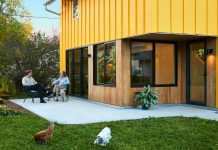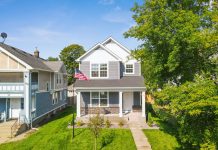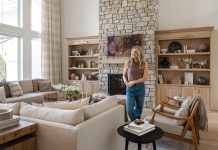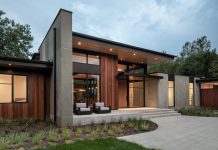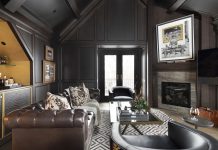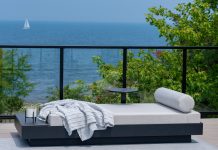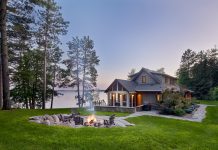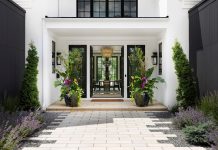(Ryan Lodermeier)
Extended Q&A
Danish-born food and garden photographer Mette Nielsen arrived in the United States in 1980. More recently, she harnessed the values and sensibilities she brought with her to help the City of Minneapolis craft a forward-thinking European-style approach to residential land use and zoning. In accordance with those new policies, she built an “accessory dwelling unit” (ADU) behind her south Minneapolis house. Her “Modern Nordic Guesthouse” (available to rent on Airbnb), is as charming as its name suggests.
What gave you the idea to build a second residence on your property?
It all started when my son, Alexander Watchman, graduated from architecture school and I thought, how fun to have him design a house for me. But I already had a house, and I didn’t want to move. Then three things happened at the same time. In 2014 the City of Minneapolis started debating whether “accessory dwelling units”[second residences on a lot] should be allowed. Then an enormous catalpa tree in my backyard had to come down. Then my son graduated from Harvard’s master’s program. And I thought, maybe without this tree we could build a house.
Did you participate in the city’s planning process?
Yes. I attended the meetings, which were horrible at first. Their original requirements were ridiculously restrictive. For instance, they wanted to match building materials on the second house. I pointed out there’s nothing to prevent me from changing the siding afterwards. Then there were parking issues. I pointed out that my neighbors have five cars. Why should they be required to have one parking space and me two? When they started to listen, things happened fast. Everything turned.

What feature are you most proud of in your unit?
It has radiant-heat floors throughout. This was huge. My utility bill for a month only increased $25 to $30. The house is passive solar. I don’t even have central air. Just a unit in the bedroom that is hardly ever needed. That’s where my son’s design sense comes in. He sited the house so that when the sun is low in the sky, in winter, it comes directly into the house through the big windows and glass doors on the south side. In the summer, when the sun is high in the sky, the house is insulated by a storage shed directly in its path. We have two ceiling fans.
What was the biggest challenge, once your son drew up the plan?
Finding a contractor. I interviewed six or seven in the first go-around and then started over. I called Gar Hargens of Close Associates, a very old friend and an architect who designs houses in the minimalist style I love. He put me together with Greg Michlitsch and Greg Arntz, who owns Gregory Arntz Construction. The Gregs, as I call them, are framers and finish carpenters and have been working together for many, many years.
I told them, “Don’t take this the wrong way, but this is basically a fancy garage, not a big deal to build.” They got that. They were awesome through the entire process. They have a combined 60 years’ experience in carpentry and they just know so much.

What was your big splurge?
I used Ikea for the kitchen but blew the budget on an “island” that’s really a cooktop/table/counter custom framed around an Ikea cabinet. It was made by a metal artist named Kristen Arden. My taste and my budget don’t overlap much, unfortunately, so I have to be disciplined.
You are planning to live in the unit eventually, right?
Yes, in about 10 years. Then I’ll find a long-term renter for my house.
Would you do it again?
In a heartbeat. But for now, I’m helping other people. I get 10 calls a week. I don’t want to turn into a consultant or anything, but I just love helping people think this through. Alexander is designing a house for a couple inspired by my house that Greg and Greg are going to build. I hope I can be a catalyst and move this whole idea along and inspire others to do it.
How do you explain the shift?
My son is 32. Young people are different in how they live—very deliberate, conscious of what they do, and why they’re doing it. There is a cohesion in their decision-making process. It isn’t just random. And money isn’t the driver.
I go to Seattle a lot because he lives there now, and I see coastal cities as being way ahead [of us] in that they encourage more of a mixed-use feel—commercial, residential, and different types of residential together because it is stimulating and efficient.
I grew up in Denmark, a country with a fifth the land of Minnesota but the same number of people. We have open spaces but they are planned, and housing is dense. There isn’t this senseless sprawl that comes with having so much land and no real boundaries. Here, you end up with suburbs whose residents have no access to what they need, like shops and restaurants and services.
Talking dollars and cents, how much did this cost, ballpark? And what does it cost to run the house when it’s booked?
All in, about $250,000 to first remove the existing one-car garage and then to excavate a foundation and then frame and finish and pour the concrete for the floors, and so on. That’s not counting the furnishings and fixtures.
The short-term rental income pays the mortgage. I haven’t had a single bad experience with a guest. And the neighbors just want to know everything about them. The people who come are so interesting.
Any pointers for someone thinking of doing this?
You just have to put the right people together. I took my time and waited until I had them. The Gregs doing all the carpentry themselves really helped because they could always be working, not waiting on a sub. And they only bought quality materials and then used every scrap of them, not wasting anything. The doors came from Heritage Millwork in Ramsey, and the lumber from Spring Lake Park Lumber.
What was cool is that the vendors would come to the site. I had a party for them all when it was done.
Digital Extra: Before and After Photos









